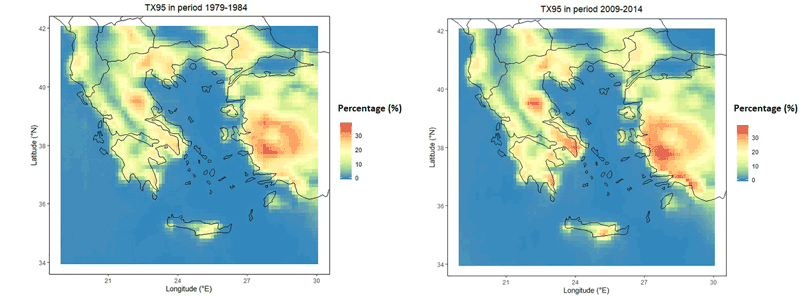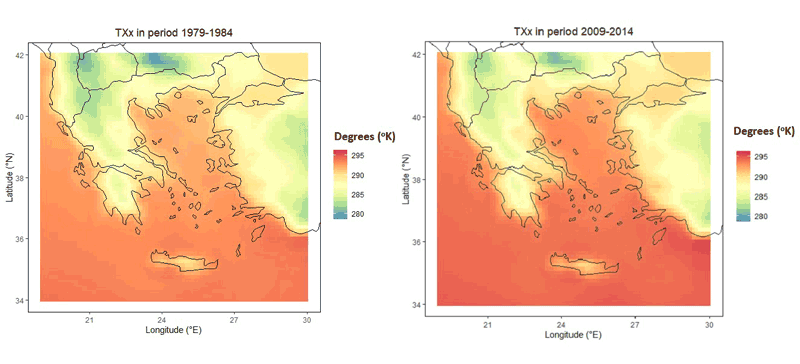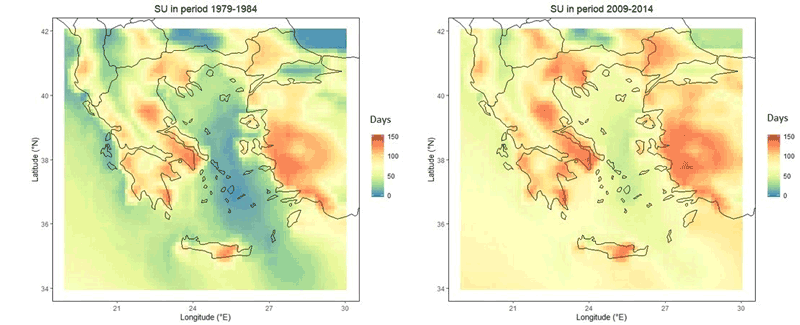by Athanasios Karavoulias and Athanassios A. Argiriou
A study analysing World Meteorological Organization (WMO) extreme climatic indexes in Greece for the period 1979-2019 to better understand the impact and the significance of extreme phenomena on the environment and humans.
Climatic extremes can have major impacts on ecosystems and urban areas. Extremes in temperature have significant effects on agriculture, forestry, industry and tourism, and can lead to huge financial loses and most importantly to loss of human life. For this reason, it is crucial to better understand these phenomena and their trends so that we can design mitigation measures and avoid future disasters. This study focuses on the trends of extreme climatic indices, and their impact on humans, in Greece over the last 40 years.
Fifteen climate indexes were examined, associated with minimum and maximum daily temperature and daily precipitation. The three indices that have greatest impact in urban areas are: the TX95, which is the annual percentage of days when the maximum temperature is above the 95th percentile; the TXX which is the monthly maximum of daily maximum temperatures; and the SU, which represents the “summer days” , or annual number of days when the maximum temperature exceeds 25o C. The indices were calculated using hourly air temperature at 2 m height for the period 1979 to 2019. The data were sourced from the ERA 5 reanalysis database [L1]. The results are presented in contour maps depicting the average value of each index during seven sub-periods and then we calculated their trends for the three largest Greek cities, namely Athens, Thessaloniki and Patra
TX95
The TX95 index shows a clear increase over time, as shown in Figure 1, especially in the continental region, with spikes over major urban areas like Athens. This indicates that warm days are becoming common and phenomena like heatwaves are more likely to occur [3]. The trend of the TX95 index is positive in the three cities.
TXX
The TXX shows a slow constant rise over the years with coastal and highly dense urban areas like Athens and Thessaloniki having the highest values (Figure 2). The increase of the TXX index indicates that there is a trend towards higher maximum temperatures that results in an increased energy demand [2]. This is further supported by the trend of the TXX index in each city, which is positive for all of them with the highest occurring in Thessaloniki.
SU
The SU index counts the annual number of days when the maximum temperature is above 25o C, a phenomenon that has increased dramatically over time (Figure 3). Every part of Greece now experiences more hot days when compared to the past, with the highest number of them occurring over large urban areas. Additionally, when we examine the trend of the SU index in both Athens and Thessaloniki we see a high positive value, results that agree with the findings of the contour maps.

Figure 1: The average value of the TX95 index in Greece for the periods 1979-1984 and 2009-2014 with an obvious increase in later years and big cities demonstrating a rise in the number of days when the temperature exceeds the 95th threshold.

Figure 2: The average value of the TXX index during the periods 1979-1984 and 2009-2014. A slight increase can be observed over the years with coastal areas suffering the most.

Figure 3: The average annual number of “summer days” in Greece for the periods 1979-1984 and 2009-2014. Peaks over the major cities are getting more intense and there is a dramatic increase in coastal areas.
Urban areas usually experience higher temperatures compared to their rural surroundings; a phenomenon described as urban heat island (UHI), caused by human activities [2]. UHI further amplifies the trend of the climate extreme indices, resulting in higher values in urban areas.
The above results indicate that Greece has a trend towards a warmer more tropical climate. The extreme indices we studied show a positive trend in every city, suggesting that there is a tendency towards a warmer environment. Furthermore, it is almost certain that there is a correlation behind this shift towards a warmer climate with human activities, something that is supported by the fact that when studying the contour maps of indices like SU and TX95 show much higher values and peaks over large cities when compared to surrounding areas.
In conclusion, there is no doubt that the climate in Greece is suffering a dramatic change with temperatures reaching even higher values and extreme phenomena getting more frequent and more severe. For this reason, it is crucial to monitor climate change constantly and seriously in order to prevent any more calamities and losses.
Link:
[L1] https://www.ecmwf.int/
References:
[1] A. Mamara, et al.: “High Resolution Air Temperature Climatology for Greece for the Period 1971–2000”, 2016.
[2] S. Magli, C. Lodi, L. Lombroso: “Analysis of the urban heat island effects on building energy consumption”, 2015.
[3] S. Feron, R. R. Cordero, A. Damiani: “Observations and Projections of Heat Waves in South America”, 2019.
Please contact:
Athanasios Karavoulias
University of Patras, Greece
Athanasios Argiriou
University of Patras, Greece











